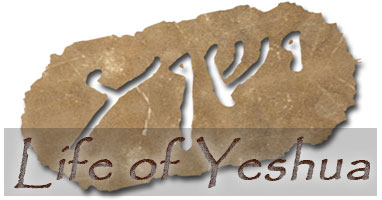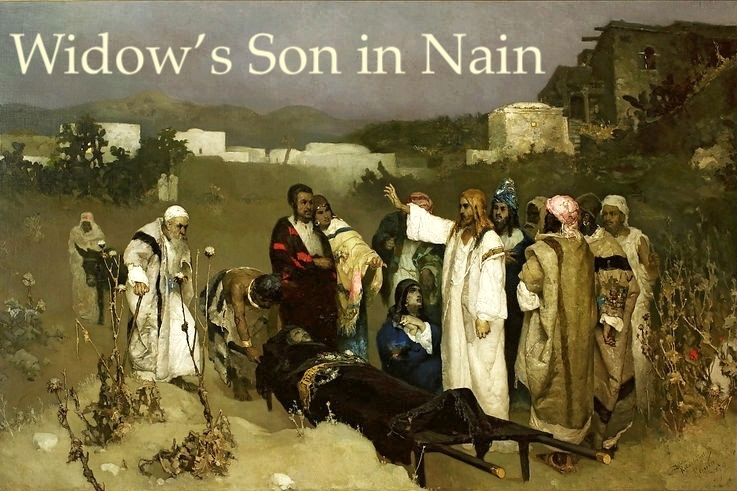How to cite this article:
David N. Bivin and Joshua N. Tilton, “Widow’s Son in Nain,” The Life of Yeshua: A Suggested Reconstruction (Jerusalem Perspective, 2014) [https://www.jerusalemperspective.com/13167/].
Luke 7:11-17
(Huck 80; Aland 86; Crook 90)[1]
Updated: 23 February 2025[2]
וַיְהִי אַחַר הַדְּבָרִים הָאֵלֶּה וַיֵּלֶךְ אֶל עִיר וּשְׁמָהּ נָעִין וַיֵּלֶךְ עִמּוֹ אֻכְלוּס גָּדוֹל וַיְהִי כַּאֲשֶׁר הִגִּיעַ אֶל פֶּתַח הָעִיר וְהִנֵּה מוֹצִיאִים מֵת יָחִיד לְאִמּוֹ וְהִיא אַלְמָנָה וַיִּרְאֶהָ הָאָדוֹן וַיְרַחֵם עָלֶיהָ וַיֹּאמֶר לָהּ אַל־תִּבְכִּי וַיִּקְרַב וַיִּגַּע בַּמִּטָּה וַיַּעַמְדוּ הַנּוֹשְׂאִים וַיֹּאמֶר נַעַרִי אֲנִי אוֹמֵר לְךָ קוּם וַיֵּשֶׁב הַמֵּת וַיָּחֶל לְדַבֵּר וַיִּתְּנֵהוּ לְאִמּוֹ וַיִפְחֲדוּ הָאֻכְלוּסִים וַיְבָרֲכוּ אֶת אֱלֹהִים לֵאמֹר נָבִיא גָּדוֹל קָם בְּקִרְבֵּנוּ וּפָקַד אֱלֹהִים אֶת עַמּוֹ וַיֵּצֵא הַדָּבָר הַזֶּה בְּכָל יְהוּדָה
And after these thing Yeshua went to a town (its name was Nain). A large crowd went with him. When he reached the entrance of the town, behold! They were bringing out a corpse of a mother’s only child, and she was a widow. The Lord saw her and had compassion on her and said to her, “Do not weep.” And he approached and touched the bier and the bearers stood still. And he said, “Young fellow, I say to you, arise!” And the dead person sat up and began to speak and Yeshua give him to his mother. The crowds were afraid and they blessed God saying, “A great prophet has arisen among us, and God has visited his people!” And this word went out into all Yehuda.[3]
| Table of Contents |
|
3. Conjectured Stages of Transmission 5. Comment 8. Conclusion |
Reconstruction
To view the reconstructed text of Widow’s Son in Nain click on the link below:
Paid Content
Premium Members and Friends of JP must be logged in to access this content: Login
If you do not have a paid subscription, please consider registering as a Premium Member starting at $10/month (paid monthly) or only $5/month (paid annually): Register
One Time Purchase Rather Than Membership
Rather than purchasing a membership subscription, you may purchase access to this single page for $1.99 USD. To purchase access we strongly encourage users to first register for a free account with JP (Register), which will make the process of accessing your purchase much simpler. Once you have registered you may login and purchase access to this page at this link:
Conclusion
The story of the raising of the widow’s son in Nain attests to the Jewish eschatological hopes current toward the end of the Second Temple period. It may also preserve an authentic recollection of a Judean ministry early in Jesus’ career. The story highlights Jesus’ compassion for fellow humans in distress, which in turn reflects Jesus’ understanding of God’s character. Far from ignoring or transgressing the commandments pertaining to ritual purity, Jesus correctly prioritized the Torah’s requirements in accordance with God’s attribute of mercy, which is surely the essence of Judaism.
![Kotarbiński_Resurrection_of_the_son[1]](https://www.jerusalemperspective.com/wp-content/uploads/2014/09/Kotarbiński_Resurrection_of_the_son1.jpg)
 Click here to return to The Life of Yeshua: A Suggested Reconstruction main page.
_______________________________________________________
Click here to return to The Life of Yeshua: A Suggested Reconstruction main page.
_______________________________________________________
- [1] For abbreviations and bibliographical references, see “Introduction to ‘The Life of Yeshua: A Suggested Reconstruction.’”
- [2] Our thanks to Georgia Clifton for noting an error in an earlier version of the reconstruction document, which allowed us to correct it—DNB and JNT.
- [3] This translation is a dynamic rendition of our reconstruction of the conjectured Hebrew source that stands behind the Greek of the Synoptic Gospels. It is not a translation of the Greek text of a canonical source.






